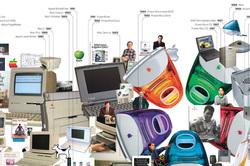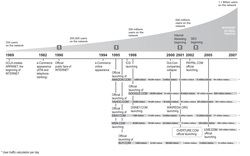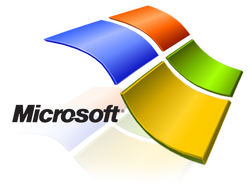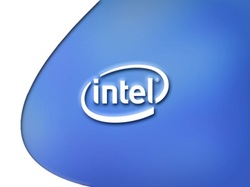Click here for closer view of the evolution of Apple MAC Computer.
The diagram provides significant data, oriented to show a complete snapshot of the evolution of important companies and events that impacted in the evolution of the E-Marketing and E-Commerce
Source : HERE
Source : HERE
When anyone hears the name Microsoft to think of one person: Bill Gates, the founder of the company. It’s said that Bill Gates is one of the smartest programmers ever. After reading an article on the Altair 8800 from the popular electronics magazine in 1975, Bill Gates called the creators of the Altair 8800, MITS, offering to demonstrate and importation of the BASIC programming language for the system. Gates had neither the Altair nor the interpreter. However, in only eight weeks, Bill and Paul Allen had created the interpreter. The interpreter worked without any glitches in the demo and MITS was located. On the basis of that, Microsoft was founded.
The name came from microcomputer and software coming up with Microsoft. The Microsoft name was registered with the secretary of state of New Mexico on November 26, 1976. Microsoft’s first international office was in Japan and found it on November 1, 1978. The name of the international office was ASCII, which is now known as Microsoft Japan. In January of 1979 the company packed up and moved its headquarters to Bellevue Washington. Steve Ballmer teamed up with Microsoft in June of 1980. The company had to restructure in June of 1981 in order to become an incorporated business in its new home state of Washington. This is when they changed the name to Microsoft Inc. As part of the restructuring, Bill Gates became the President of the Company and the Chairman of the Board and Paul Allen became the Executive VP.
Microsoft released their first operating system in 1980. It was a variant of Unix. AT&T acquired the system through a distribution license, calling it Xenix. They then hired Santa Cruz operation to help to port/adapt the operating system to several platforms. This variant would become home to the first version of Microsoft’s word processor. The company went on to produce several other programs after this one. However, the disk operating system also known as DOS was the one to bring them true success. In August of 1981 IBM warded a contract to Microsoft to provide a version of the CP/M. clone called 86 -- TOS. This deal went down for less than 50,000. IBM then renamed 86-DOS to PC-dos. They changed the name due to the fact of copyright infringement problems. IBM then marketed both CP/M. and PC-DOS. CP/M. was sold for $240 and PC-DOS was sold for $40. PC-DOS became the standard edition because of its lower price.
In 1983 Microsoft created their very first own home computer system. They named it MSX. MSX contained its own version of die DOS operation system. This very own system became very popular in South America, Japan, and Europe. Later on, the market was flooded with IBM PC clones after Columbia data products successfully cloned the IBM BIOS. This very deal allowed IBM to have total control of its own QDOS and MS-DOS. Soon powering this. Microsoft rose to one of the major software vendors in the home computer industry. Microsoft released a program called Microsoft Mouse in May of 1983 expanding its product line and other markets. Ever since then Microsoft has been the biggest largest player in the industry for creating top-of-the-line software, such as their most famous product Windows.
In 2001 Microsoft entered the PC gaming world with their Xbox system. This was the first gaming console system to be released in the Gaming Market. The Xbox ranked second to Sony’s PlayStation 2. The console sold 24 million units compared to PlayStation 2 at 100 million units. The company took a $4 billion loss on the console. It was then discontinued in late 2006. In May of 2005, Microsoft unveiled their Xbox 360 gaming console. The console had people standing out in the cold waiting to get their hands on one for hours. As soon as they hit the shelves they were sold out completely. As of January 20009 28,000,000 units have been sold worldwide. Today the Xbox 360 is one of the hottest gaming system available on the market today.
Source : HERE
The name came from microcomputer and software coming up with Microsoft. The Microsoft name was registered with the secretary of state of New Mexico on November 26, 1976. Microsoft’s first international office was in Japan and found it on November 1, 1978. The name of the international office was ASCII, which is now known as Microsoft Japan. In January of 1979 the company packed up and moved its headquarters to Bellevue Washington. Steve Ballmer teamed up with Microsoft in June of 1980. The company had to restructure in June of 1981 in order to become an incorporated business in its new home state of Washington. This is when they changed the name to Microsoft Inc. As part of the restructuring, Bill Gates became the President of the Company and the Chairman of the Board and Paul Allen became the Executive VP.
Microsoft released their first operating system in 1980. It was a variant of Unix. AT&T acquired the system through a distribution license, calling it Xenix. They then hired Santa Cruz operation to help to port/adapt the operating system to several platforms. This variant would become home to the first version of Microsoft’s word processor. The company went on to produce several other programs after this one. However, the disk operating system also known as DOS was the one to bring them true success. In August of 1981 IBM warded a contract to Microsoft to provide a version of the CP/M. clone called 86 -- TOS. This deal went down for less than 50,000. IBM then renamed 86-DOS to PC-dos. They changed the name due to the fact of copyright infringement problems. IBM then marketed both CP/M. and PC-DOS. CP/M. was sold for $240 and PC-DOS was sold for $40. PC-DOS became the standard edition because of its lower price.
In 1983 Microsoft created their very first own home computer system. They named it MSX. MSX contained its own version of die DOS operation system. This very own system became very popular in South America, Japan, and Europe. Later on, the market was flooded with IBM PC clones after Columbia data products successfully cloned the IBM BIOS. This very deal allowed IBM to have total control of its own QDOS and MS-DOS. Soon powering this. Microsoft rose to one of the major software vendors in the home computer industry. Microsoft released a program called Microsoft Mouse in May of 1983 expanding its product line and other markets. Ever since then Microsoft has been the biggest largest player in the industry for creating top-of-the-line software, such as their most famous product Windows.
In 2001 Microsoft entered the PC gaming world with their Xbox system. This was the first gaming console system to be released in the Gaming Market. The Xbox ranked second to Sony’s PlayStation 2. The console sold 24 million units compared to PlayStation 2 at 100 million units. The company took a $4 billion loss on the console. It was then discontinued in late 2006. In May of 2005, Microsoft unveiled their Xbox 360 gaming console. The console had people standing out in the cold waiting to get their hands on one for hours. As soon as they hit the shelves they were sold out completely. As of January 20009 28,000,000 units have been sold worldwide. Today the Xbox 360 is one of the hottest gaming system available on the market today.
Source : HERE
Intel began in 1968. It was founded by Gordon E. Moore who is also a physicist and chemist. He was accompanied by Robert Noyce, also a fellow physicist and co-creator of integrated circuitry, after they both had left Fairchild Semiconductor. During the 1980’s Intel was run by a chemical engineer by the name of Andy Grove, who was the third member of the original Intel family. Many other Fairchild employees participated in other Silicon Valley companies. Andy Grove today is considered to be one of the company’s essential business and strategic leaders. As the 1990’s concluded, Intel had become one of the largest and by far the most successful businesses in the entire world. Intel has gone through many faces and phases. In the beginning Intel was set apart by its ability primarily to create memory chips or SRAM.
When the firm was founded, Gordon Moore and Robert Noyce had the idea to name their company Moore Noyce. However when the name is spoken it is heard as “More Noise” This idea was quickly abandoned and the pursuit of a more suitable name – one which was not associated with a bad interface. The name NM Electronics was shortly thereafter chosen and used for nearly a year, when the company experienced a name change to Integrated Electronics, or INTEL for short. The rights to the name however had to be purchased as it was already in use by a fairly well known hotel chain.
Though Intel had mastered the first microprocessor called the Intel 4004 in 1971 and also one of the worlds very first microcomputers in 1972, in the early 80’s the focus was primarily on Random Access Memory chips. A new client in the early 70’s from Japan wanted to enlist the services of Intel to design twelve chips for their calculators. Knowing that they did not have the manpower or the resources to complete this job effectively, Ted Hoff agreed to the job just the same. His idea was: What if we can design one computer chip which could function the same as twelve microchips?. Hoof’s idea was completely embraced by Moore and Noyce. If this project were successful the chip would have the ability to receive command functions. This is where the 4004 model came from. After a painstaking 9 months. It measured 1/8th inch by 1/6th inch long and contained 2,300 transistors. History was made and changed that day.
The Pentium Pro processor had 5.5 million transistors, making the chip so affordable that it could be imbedded in common household appliances. After this success Intel decided to completely embrace this and to pursue its production.
Some notable dates in the history of Intel are:
1968 Robert Noyce and Gordon Moore incorporate NM Electronics
1970 The development of DRAM and dynamic RAM
1971 The world’s first microcomputer is introduced
1974 The first general purpose microprocessor is introduced to the world
1980 The Intel microprocessor is chosen by IBM for the first ever personal computer. 1992 Intel’s net income tops the one billion dollar point
1993 The Pentium is introduced, a fifth generation chip
1996 Intel’s revenue exceeds twenty billion dollars and the net income surpasses five billion dollars
1997, The Pentium 11 microprocessor is introduced to the world
1999 Intel is added to Dow Jones Averages.
2000 The world’s very first Intel 1 gigahertz processor hits the shelves.
To this day Intel continues to make strides in the computing and micro computing world.
Source : HERE
When the firm was founded, Gordon Moore and Robert Noyce had the idea to name their company Moore Noyce. However when the name is spoken it is heard as “More Noise” This idea was quickly abandoned and the pursuit of a more suitable name – one which was not associated with a bad interface. The name NM Electronics was shortly thereafter chosen and used for nearly a year, when the company experienced a name change to Integrated Electronics, or INTEL for short. The rights to the name however had to be purchased as it was already in use by a fairly well known hotel chain.
Though Intel had mastered the first microprocessor called the Intel 4004 in 1971 and also one of the worlds very first microcomputers in 1972, in the early 80’s the focus was primarily on Random Access Memory chips. A new client in the early 70’s from Japan wanted to enlist the services of Intel to design twelve chips for their calculators. Knowing that they did not have the manpower or the resources to complete this job effectively, Ted Hoff agreed to the job just the same. His idea was: What if we can design one computer chip which could function the same as twelve microchips?. Hoof’s idea was completely embraced by Moore and Noyce. If this project were successful the chip would have the ability to receive command functions. This is where the 4004 model came from. After a painstaking 9 months. It measured 1/8th inch by 1/6th inch long and contained 2,300 transistors. History was made and changed that day.
The Pentium Pro processor had 5.5 million transistors, making the chip so affordable that it could be imbedded in common household appliances. After this success Intel decided to completely embrace this and to pursue its production.
Some notable dates in the history of Intel are:
1968 Robert Noyce and Gordon Moore incorporate NM Electronics
1970 The development of DRAM and dynamic RAM
1971 The world’s first microcomputer is introduced
1974 The first general purpose microprocessor is introduced to the world
1980 The Intel microprocessor is chosen by IBM for the first ever personal computer. 1992 Intel’s net income tops the one billion dollar point
1993 The Pentium is introduced, a fifth generation chip
1996 Intel’s revenue exceeds twenty billion dollars and the net income surpasses five billion dollars
1997, The Pentium 11 microprocessor is introduced to the world
1999 Intel is added to Dow Jones Averages.
2000 The world’s very first Intel 1 gigahertz processor hits the shelves.
To this day Intel continues to make strides in the computing and micro computing world.
Source : HERE



